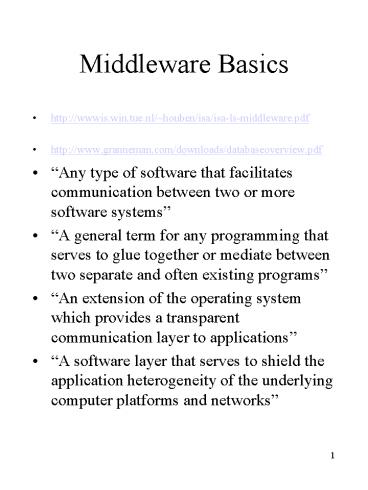Middleware Basics - PowerPoint PPT Presentation
1 / 14
Title:
Middleware Basics
Description:
... (MOM) offers a mailbox abstraction, asynchronous mode, generally queuing ... offers an object abstraction, synchronous/ asynchronous client/server ... – PowerPoint PPT presentation
Number of Views:72
Avg rating:3.0/5.0
Title: Middleware Basics
1
Middleware Basics
- http//wwwis.win.tue.nl/houben/isa/isa-ls-middlew
are.pdf - http//www.granneman.com/downloads/databaseovervie
w.pdf - Any type of software that facilitates
communication between two or more software
systems - A general term for any programming that serves
to glue together or mediate between two separate
and often existing programs - An extension of the operating system which
provides a transparent communication layer to
applications - A software layer that serves to shield the
application heterogeneity of the underlying
computer platforms and networks
2
Middleware Scenario
- Web server passes the request for data from a
database to the middleware - Middleware renders it into a form meaningful as a
query to the database - Database responds with data to the middleware
- Middleware formats into html and sends it to the
Web server - Web server sends the page to the user making the
request
3
Middleware Models
- Point-to-Point Middleware Linking one
application to another, sending a procedure call
or message without engaging in middle-tier
processing in terms of logic or mapping - Many-to-many Linking each application to many
other applications making use of integration
servers and other variations
4
Communication Modes
- Synchronous client waits for the result,
coupling the applications tightly, and making
unnecessarily wasteful use of the communication
medium. A somewhat better alternative would be
deferred Synchronous mode where the client asks
for result by polling. Either way the nature of
communication is direct - Asynchronous Client send the request and
continues with its work. The server initiates
contact with the client when ready with results - Queued In most cases the messages for the
server may be queued and processed one-by-one in
some order of priority
5
(Continued )
- Publish/Subscribe sending request to a pub/sub
engine or broker. The broker then forwards it to
interested (subscribing) applications. Allows
for anonymity, flexibility, and generality among
participating applications - Fire/Forget broadcasting messages to multiple
applications JAXM (Java API for XML Messaging)
supports synchronous/asynchronous calls with
acknowledgements and the fire/forget messaging
option
6
Middleware Categories
- Transaction Oriented offers a tuple abstraction
(SQL) and distributed transaction processing - Examples
- IBM CICS, Encina
- BEA Tuxedo
- Microsoft Transaction Server
- LDAP - Lightweight Directory Access Protocol, is
an Internet protocol that email programs use to
look up contact information from a server, such
as ClickMail Central Directory, a simple protocol
to access remote directories, and not
transactions, LDAP servers index all the data in
their entries, and "filters" may be used to
select just the person or group you want, and
return just the information you want
7
(Continued )
- Message-oriented Middleware (MOM) offers a
mailbox abstraction, asynchronous mode, generally
queuing software, not requiring direct
connection, there are some implementations that
rely on a broadcast or multicast messaging system - Examples
- Microsoft Message Queue (MQ)
- TIBCO Rendezvous
- IBM Websphere MQ (MQSeries MQSeries)
- Sonic Software's SonicMQ
- Java Message Queue
- Coridan MantaRay (http//www.mantamq.org) (open
source) - ActiveMQ (open source)
- XmlBlaster (http//www.xmlblaster.org) an
open-source Java MOM implementation
8
(Continued )
- Procedural Middleware (RPC) offers a procedural
abstraction, synchronous client/server
interaction, RPC allows server components to be
defined using an IDL, compiling client server
stubs, suffer from scalability problems - Examples
- Sun Open Network Computing (ONC)
- Unix/Linux/DCE RPC
- OSF DCE
- Netbula JavaRPC
- PowerRPC
9
(Continued )
- Object-Oriented Middleware offers an object
abstraction, synchronous/ asynchronous
client/server interaction, Like RPC (Remote
Procedure Call), OOM offers synchronous, typed
communication between components of a distributed
program, system-wide through the Object Directory
(Interface Trader, Yellow Pages) - Examples
- OMG CORBA
- Sun Java/RMI
- SOAP (RPC on top of HTTP, XML RPC)
- Microsoft COM/DCOM
- Sun Enterprise Java Beans
- .NET (Virtual Machine like Java)
10
(Continued ..)
- Transaction Monitors runtime software that
monitors a transaction as it passes from one
stage in a process to another, ensuring that the
transaction processes completely or, if an error
occurs, to take appropriate actions, TP monitors
are especially important in three-tier
architectures that employ load balancing because
a transaction may be forwarded to any of several
servers based on their availability, TP monitor
technology provides the distributed client/server
environment the capacity to efficiently and
reliably develop, run, and manage transaction
applications.
11
(continued )
- Application Servers generally operate as web
enabled middleware, processing actions from web
enabled applications, providing application logic
processing and sharing, connecting to backend
resources
12
(continued )
- Integration Servers can account for differences
in cooperating application semantics and
platforms, transforming message schemas and alter
the contents as needed
13
Other Middleware Examples
- Closed Source MS ASP, Macromedia Cold Fusion
- Closed/Open UserLand Frontier/Manila
- Open Source PHP/MySQl, JSP, Perl, Python, Zope
(built with Python)
14
PHP Scenario
- A web browser issues a request for a file with
.php extension - Web Server takes this file and sends it as an
input request to the PHP parser - The PHP parser finds PHP specific code in the
file, processes it, and places the output back in
the file in place of the PHP code - The new output file is sent back to the web
server - Web server sends the file to the requesting
browser - The browser displays the output































